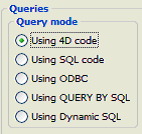This is the legacy 4D documentation web site. Documentations are progressively being moved to developer.4d.com
- 4D SQL Reference
-
- Tutorial
-
-
 Introduction
Introduction
-
 Receiving an SQL query result in a variable
Receiving an SQL query result in a variable
-
 Using the WHERE clause
Using the WHERE clause
-
 Receiving an SQL query result into arrays
Receiving an SQL query result into arrays
-
 Using CAST
Using CAST
-
 Using the ORDER BY clause
Using the ORDER BY clause
-
 Using the GROUP BY clause
Using the GROUP BY clause
-
 Using Statistical functions
Using Statistical functions
-
 Using the HAVING clause
Using the HAVING clause
-
 Calling 4D methods inside the SQL code
Calling 4D methods inside the SQL code
-
 Joins
Joins
-
 Using Aliases
Using Aliases
-
 Subqueries
Subqueries
-
 SQL code error tracking and debugging
SQL code error tracking and debugging
-
 Data Definition Language
Data Definition Language
-
 External connections
External connections
-
 Connection to the 4D SQL engine via the ODBC Driver
Connection to the 4D SQL engine via the ODBC Driver
-
4D v20 R8
Receiving an SQL query result in a variable
 Receiving an SQL query result in a variable
Receiving an SQL query result in a variable
To start with a very simple query: we would like to know how many movies are in the Video Library. In the 4D language, the code would be:
C_LONGINT($AllMovies)
$AllMovies:=0
ALL RECORDS([MOVIES])
$AllMovies:=Records in selection([MOVIES])
ALERT("The Video Library contains "+String($AllMovies)+" movies")- The first way to interact in a similar manner with the SQL engine is by placing the query between the Begin SQL and End SQL tags. Thus, the simple query above becomes:
C_LONGINT($AllMovies)
$AllMovies:=0
Begin SQL
SELECT COUNT(*)
FROM MOVIES
INTO <<$AllMovies>>
End SQL
ALERT("The Video Library contains "+String($AllMovies)+" movies")
- As you can see, you can receive the result of the query in a variable (in our case $AllMovies) that is enclosed between "<<" and ">>".
Another way to reference any type of valid 4D expression (variable, field, array, “expression…”) is to place a colon ":" in front of it:C_LONGINT($AllMovies)
$AllMovies:=0
Begin SQL
SELECT COUNT(*)
FROM MOVIES
INTO :$AllMovies
End SQL
ALERT("The Video Library contains "+String($AllMovies)+" movies")
Special attention should be paid to inter-process variables, where the notation is a little bit different: you must place an inter-process variable between "[" and "]":C_LONGINT($AllMovies)
<>AllMovies:=0
Begin SQL
SELECT COUNT(*)
FROM MOVIES
INTO <<[<>$AllMovies]>>
End SQL
ALERT("The Video Library contains "+String(<>AllMovies)+" movies")
- The second way to interact with the SQL engine is using integrated generic SQL (ODBC compatible) commands. Thus the simple query above becomes:
C_LONGINT($AllMovies)
$AllMovies:=0
` Initialize a connection with the internal SQL engine
SQL LOGIN(SQL_INTERNAL;"";"")
` Execute the query and return the result in the $AllMovies variable
SQL EXECUTE("SELECT COUNT(*) FROM MOVIES";$AllMovies)
` Retrieve all the records found
SQL LOAD RECORD(SQL all records)
` Close the connection
SQL LOGOUT
ALERT("The Video Library contains "+String($AllMovies)+" movies")
For more information concerning generic SQL commands, please refer to SQL section of the 4D Language Reference manual.
- The third way to interact with the new SQL engine is using the 4D QUERY BY SQL command. In this situation, the simple query above becomes:
C_LONGINT($AllMovies)
$AllMovies:=0
QUERY BY SQL([MOVIES];"ID <> 0")
$AllMovies:=Records in selection([MOVIES])
ALERT("The Video Library contains "+String($AllMovies)+" movies")
In fact, the QUERY BY SQL command can be used to execute a simple SELECT query that can be written as follows:SELECT *
FROM myTable
WHERE <SQL_Formula>
myTable is the name of the table passed in the first parameter and SQL_Formula is the query string passed as the second parameter:QUERY BY SQL(myTable;SQL_Formula)
In our case there is no WHERE clause, so we forced one: "ID <> 0". The equivalent in SQL for the whole query would be:SELECT *
FROM MOVIES
WHERE ID <> 0
- The fourth way to interact with the new SQL Engine is using the dynamic SQL EXECUTE IMMEDIATE command. The query above becomes
C_LONGINT(AllMovies)
AllMovies:=0
C_TEXT(tQueryTxt)
tQueryTxt:="SELECT COUNT(*) FROM MOVIES INTO :AllMovies"
Begin SQL
EXECUTE IMMEDIATE :tQueryTxt;
End SQL
ALERT("The Video Library contains "+String(AllMovies)+" movies")
Warning: You can see that in this last example, we use process variables. This is necessary when you want to use the database in compiled mode. In this context, in fact, it is not possible to use local variables with the EXECUTE IMMEDIATE command.
To test all the above examples, launch the "4D SQL Code Samples" database and go to the main dialog box. On the left side of the dialog, you can choose the query mode:

Then press the SQL query results in variables button.
PROPERTIES
Product: 4D
Theme: Tutorial
PAGE CONTENTS
HISTORY
ARTICLE USAGE
4D SQL Reference ( 4D v20 R8)









